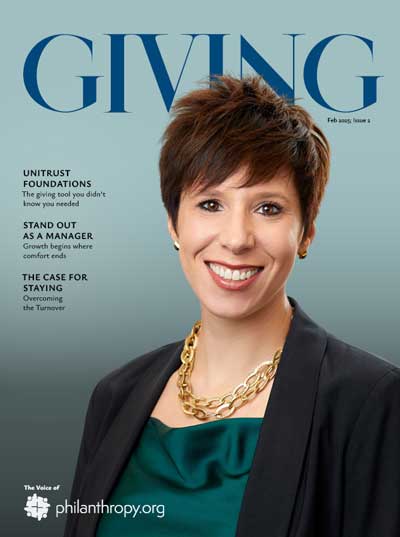The Future of Philanthropy Doesn't Begin at 40
The truth is, many in our field haven’t fully reckoned with the fact that today’s youth will be wealthier than they are.
For decades, fundraising professionals have focused on prospects aged 40 and up. They send mailers to retirees, host luncheons for grandparents, and pitch estate planning tools to Baby Boomers. This approach isn’t inherently wrong—but it is shortsighted.
If your fundraising strategy begins at 40, you’ve already missed the most important window: youth.
Today’s children, teens, and young adults—ages 9 to 22—aren’t just future philanthropists. They are future leaders, innovators, and wealth holders. If you wait until they “settle down” to teach them about giving, you will have lost your chance.
If your fundraising strategy begins at 40, you've already missed the most important window: youth.
Tweetable Tweet
Youth Will Control More Wealth Than Any Generation Before
Youth Philanthropy Must Begin Now—Before the $84 Trillion Wealth Transfer Peaks
Tweetable Tweet
Let’s look at the data. America is currently undergoing the largest wealth transfer in history. Between now and 2045, an estimated $84.4 trillion will shift from older generations to Millennials and Gen Z.
By 2035, Gen Z is projected to control $36 trillion in assets—and they’re just getting started.
This isn’t a slow trickle of inherited IRAs and family homes. It’s a generational flood. But here’s the bigger truth:
Your audience is already here. Statistically, many of today’s young people—especially those already in top income brackets—will become tomorrow’s major donors. The top 10% of American households currently control over 67% of the nation’s wealth. That wealth is shifting early, not late.
Here’s the critical insight: that top 10% isn’t emerging at age 40. They’re sitting in classrooms, launching startups, and making career decisions right now. Engaging young people in philanthropy today means reaching the statistical future of American wealth concentration.
They are right in front of you.
They’re Not Just Inheriting Wealth—They’re Building It
The common narrative says Millennials and Gen Z are financially fragile. That’s fiction.
We are living in the golden age of entrepreneurship—and, for once, even the government seems to be getting out of the way long enough for it to flourish. From AI development to global business incentives, innovation is thriving—not because of top-down mandates, but because ambitious individuals are solving real problems faster than institutions can regulate them.
These younger generations are:
- Launching startups from college dorms
- Developing apps before graduating high school
- Creating media empires on social platforms
- Investing in crypto, real estate, and AI
This isn’t speculative. Look at Whitney Wolfe Herd, who founded Bumble at age 25 and became a billionaire before 35. Or Tiffanie Davis Henry, who scaled a brand on social platforms and is now investing in startups and social ventures.
These young wealth creators share something important: they’re building businesses that solve problems and create value. This entrepreneurial mindset—focused on innovation, risk-taking, and merit-based success—shapes how they think about giving back. They are the future of philanthropy, and they want to see their philanthropic investments create measurable impact, just like their business investments.
We’re not just talking about who will receive wealth—we’re looking at those who are already creating it.
If We Don’t Build Youth Philanthropy Education, They Won’t Learn It Later
Behavioral psychology tells us habits form early. If we want philanthropy to become a natural part of a person’s identity, we need to embed it when they’re young—not after they’ve built their first million.
Most nonprofit professionals approach giving as something people do “after they’ve made it.” That mindset is outdated and limiting.
The Real Reason We Don’t Teach Youth Philanthropy
Let’s be honest: the reason we’re not reaching young people isn’t a lack of strategy—it’s a lack of long-term vision.
Many today are locked into short-term thinking. Their jobs depend on hitting this year’s goals: quarterly retention rates, annual fund campaigns, board reports. Youth philanthropy? It doesn’t move the needle this month, so it gets sidelined.
The result? We’re stuck in a cycle of chasing immediate results while neglecting the next generation entirely.
At the same time, we’re sending young people mixed messages. In one breath, we tell them that building wealth is suspect. In the next, we ask wealthy individuals to fund our movements, programs, and future. That kind of moral dissonance doesn’t just confuse donors—it discourages them. And when success is treated like a liability instead of a responsibility, we shouldn’t be surprised when generosity takes a back seat. If we want young people to embrace philanthropy, we can’t vilify the very success that makes generosity possible.
And it’s not just a tactical failure—it’s a strategic one. If we don’t teach giving early, we lose the opportunity to shape the values of those who will soon control trillions in wealth. We’re not just missing small gifts—we’re forfeiting a philanthropic future.
Fundraising professionals must move beyond job preservation and start thinking like nation-builders. Philanthropy isn’t just about funding programs. It’s about sustaining a culture of generosity for decades to come.
A Culture of Thinking Generations Ahead
Some societies are renowned for their long-term thinking. Japan, for example, is often cited as a country that plans three to four generations into the future—a mindset embedded in everything from urban planning to corporate governance. Imagine if our philanthropic strategies did the same.
What if we didn’t just plan for this fiscal year’s annual fund—but for the values and habits of a 10-year-old who might fund our mission in 15 years? That’s what real vision looks like.
How to Build Effective Youth Philanthropy Programs
Creating meaningful youth philanthropy education requires more than good intentions. Here’s your tactical roadmap to shape the future of philanthropy:
Start in Middle School: Ages 11–14
Don’t wait for high school. Research shows charitable attitudes form between ages 10–14.
What to implement:
- Partner with schools to create “Philanthropy 101” assemblies
- Develop age-appropriate giving challenges ($1–$5 donations that add up to real impact)
- Create youth advisory boards where students help allocate small grants
- Launch peer-to-peer campaigns around causes young people care about
Address the objection: “But they don’t have money!”
This isn’t about dollar amounts. A middle schooler who gives $3 and sees the impact is learning the same principle as a CEO who gives $30,000.
Integrate into High School Financial Literacy: Ages 15–18
Work with educators to include philanthropy in financial education.
What to implement:
- Create “Giving Portfolio” projects where students research and recommend charitable investments
- Offer internships and volunteer leadership roles with real responsibility
- Host “Future Philanthropist” summits where teens learn from young donors
- Partner with entrepreneurship classes to teach “profit with purpose” models
Address the objection: “Schools don’t have time for this!”
Frame it as enhanced financial literacy—something schools are already required to teach.
Connect with College Business Programs: Ages 18–22
This is when next-gen donors make career decisions that shape their lifetime giving capacity.
What to implement:
- Guest lecture in business ethics and entrepreneurship courses
- Offer case study competitions focused on nonprofit innovation
- Create mentorship programs pairing students with philanthropic peers
- Develop “Social Impact MBA” tracks or certificate programs
Address the objection: “College students are broke!”
Focus on skill-building and network-building now. These students are choosing careers and building relationships that will define their lifelong wealth—and giving—potential. They will be shaping the future of philanthropy.
Feature Young Donors Prominently
Stop hiding your young supporters. Make them the face of your movement.
What to implement:
- Create “Next Gen Donor” spotlight series in newsletters and social media
- Host young donor panels at fundraising events
- Develop peer-to-peer campaigns led by supporters under 30
- Share impact stories showing how small gifts from young donors create big change
Rethinking Fundraising: From Donor Outreach to Leadership Development
It’s time to stop thinking in terms of donors and start thinking in terms of future leaders. If the next generation isn’t being exposed to why and how giving matters, we’re not just missing donations—we’re missing the movement.
Building comprehensive youth philanthropy education today means creating the philanthropic leaders of tomorrow.
Ready to Start?
Three Youth Philanthropy Programs You Can Launch This Quarter
Program 1: The $5 Challenge (Launch in 30 days)
Partner with local schools for a monthlong challenge. Each student contributes $5 and learns about your mission.
Goal: 100 students = $500 raised + 100 new young advocates.
Program 2: Young Advisor Council (Launch in 60 days)
Recruit 8–12 students to serve on a youth advisory board. Give them a $2,000–5,000 budget to allocate toward youth-focused initiatives. Meet quarterly and provide leadership development.
Program 3: Next Gen Donor Society (Launch in 90 days)
Create a giving society for donors under 35:
- Minimum gift: $100–$500 annually.
- Benefits: exclusive networking events, behind-the-scenes access, and mentorship with established donors. A perfect bridge between youth engagement and major gift cultivation.
Future Gifts Start with Current Investment
The most successful nonprofits in the next 20 years will be the ones that invest in developing future philanthropists today. They’ll understand that influence begins early—and that giving isn’t a transaction. It’s a belief system.
So go ahead—host the gala, plan the campaign, promote the will-planning toolkit.
But don’t forget the most important audience of all: the 11-year-old future entrepreneur, the 16-year-old coding genius, the 20-year-old changemaker … the future of philanthropy.
They’re the ones who will fund your mission tomorrow. Start building those relationships today.
Start Small—Think Long-Term
Teaching philanthropy early sets the stage for a lifetime of generosity—including, eventually, planned giving. And thanks to simple tools and online platforms, even small nonprofits can now offer legacy options without complexity. It starts with values, not paperwork.






